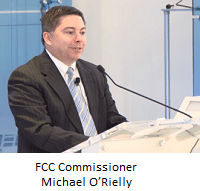
He suggested freeing up 200-300 MHz of C-band spectrum during a speech before the American Enterprise Institute, a conservative think tank in Washington, D.C. He’s pushed for re-allocation of the 3.7 to 4.2 GHz band, based on interest by both wireless and satellite companies and urged his colleagues to get a proposed rulemaking out this summer to explore issues like licensing.
At the same time, the Commission placed a temporary “freeze” on applications for new or modified fixed satellite service earth stations and fixed microwave stations in the band, to preserve the current landscape of authorized operations, pending Commission action. The Commission established GN Docket No. 18-122, titled “Expanding Flexible Use of the 3.7 GHz to 4.2 GHz Band,” and encourages the public to submit ideas on this topic.
The FCC last week began seeking input on auction procedures for the 24 and 28 GHz band auctions, Inside Towers reported. “This will help set the stage to make available new millimeter wave spectrum,” said O’Rielly. “The next step will be to finalize the rules and set an auction timetable for all the remaining high bands, starting with 37 and 39 GHz.”
The Commission is focused on freeing up more mid-band spectrum for 5G too. In the next few months, it will complete its review of the 3.5 GHz, or Citizens Broadband Radio Service (CBRS) band, a priority access license structure, and adopt new rules, said O’Rielly. The agency is taking steps to make dynamic spectrum sharing operational so unused spectrum is available, while protecting Naval incumbent users.
Both O’Rielly and colleague Jessica Rosenworcel suggested the agency publish an auction schedule so wireless carriers can form business plans, create auction strategies and obtain financial resources to take part. “Did we not learn anything after the 600 MHz incentive auction?” O’Rielly asked rhetorically. “Companies have balance sheets, debt-equity ratios, and responsibilities to shareholders, and they need the requisite time to plan,” he said.
April 24, 2018




Reader Interactions